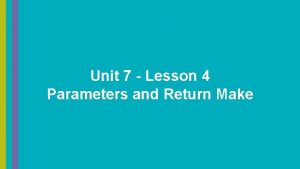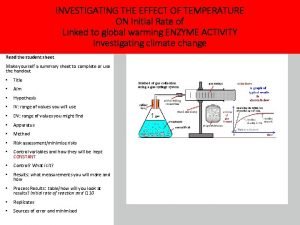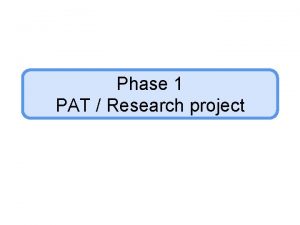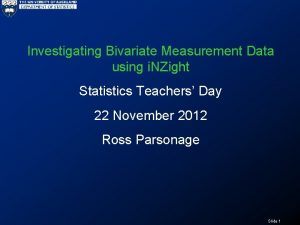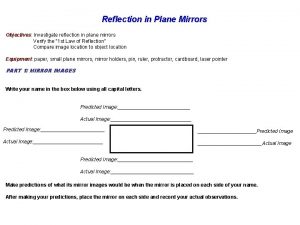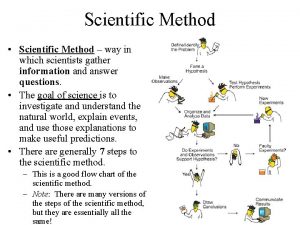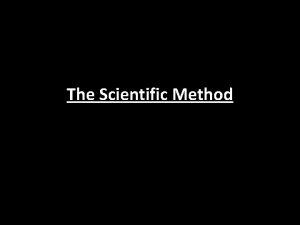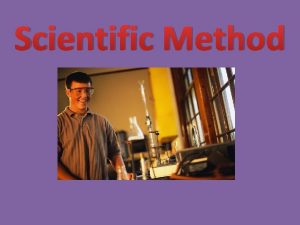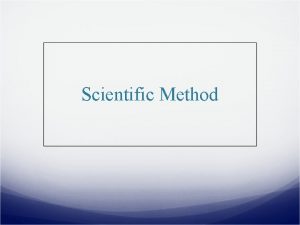Scientific Method Process through which scientists investigate and









- Slides: 9

• Scientific Method – Process through which scientists investigate and learn about the natural world – Biology: Completed through controlled experimentation, or gathering data (“field studies”)


Steps: • Observations which lead to a …. • Purpose or Problem: What you are trying to figure out by doing the experiment. – Ex: You are a medical researcher who has reason to believe that honey could be used to treat infections caused by bacteria. So you decide to do experiment to determine if this is true. Your purpose/problem then is – Does honey kill Staphylococcus bacteria? • Hypothesis: Your educated prediction of the results. Must be testable! – Ex: He thinks honey will kill the Staphylococcus bacteria.

Steps: • Hypothesis: Your educated prediction of the results. Must be testable! – Ex: He thinks honey will kill the Staphylococcus bacteria. • What are some other examples of Hypotheses? • Data (0 bservations): – Quantitative – Qualitative

Experiment: • Procedure followed to complete the experiment. – Ex: He takes two petri dishes with bacteria and puts some honey in one dish and leaves one without honey. • Important parts of an controlled experiment: – Only test one new thing at a time to see if it makes a difference in the results • This “new thing” is called the INDEPENDENT VARIABLE (manipulated variable) – Ex: independent variable = honey • Must have at least 2 groups: – Experimental group: group with independent variable. » Ex: experimental group = Bacteria with the honey – Control group: group with. OUT independent variable. » Ex: Bacteria without the honey

– Must leave everything else the same (constant) to be sure that your results are only due to the independent variable and nothing else. (I call these “constants”) • Ex: constants: same type of bacteria, same type of petri dish, same starting number of bacteria, same place putting the dishes during the experiment, same type of bacteria food (agar) etc.

Results: • What you’re testing for is called the dependent variable (or responding variable) – Ex: dependent (responding) variable = the number of surviving bacteria after exposure to the honey • Presented in data tables and/or graphs • Two types of data: – Quantitative: Number results ex: 20 bacteria – Qualitative: descriptive observations ex: round bacteria • Must show results of control group and experimental group to see if manipulated variable made a difference Starting bacteria Ending Bacteria Without honey 20 20 With honey 4 20

Conclusion • Concluding statement based on results – Example: Based on the results, the *bacteria did not survive when exposed to the honey. • Summary of Data and Results – Example continued: Only four of the bacteria in the dish with honey survived, yet all 20 *bacteria survived without the honey. So 16 *bacteria died with the honey, but no *bacteria died in the dish without the honey. • Was your hypothesis correct or not? Explain – Example continued: The hypothesis was correct. The honey did kill some of the *bacteria. • Be SPECIFIC! – Example: Don’t just say “bacteria” like above, instead say the exact type of bacteria that was tested on…. *Staphylococcus bacteria • NO opinions or assumptions – Example: Do NOT say WHY the honey killed the bacteria…(the “why” was not tested for in this experiment. )

After Experiments are Completed: • Many times, experimental results lead to new questions for new experiments. – Ex: Does honey kill other types of bacteria? Would the honey work better if it was under a piece of gauze or if left exposed to the air? Or do some types of honey kill bacteria better than others? • Theory – idea/hypothesis that has been tested many times and is well supported by data…a lot of evidence to support it
 Scientific inquiry vs scientific method
Scientific inquiry vs scientific method Tangential sawing
Tangential sawing Lesson 4 parameters and return make
Lesson 4 parameters and return make Oedipus rex play review
Oedipus rex play review Initial rate of reaction
Initial rate of reaction How to investigate a problem
How to investigate a problem Bivariate measurement data
Bivariate measurement data Investigate reflection
Investigate reflection Scientific method vs engineering design process
Scientific method vs engineering design process Scientific method vs engineering design process
Scientific method vs engineering design process


